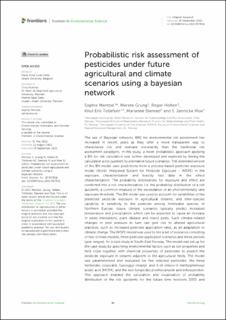| dc.description.abstract | The use of Bayesian networks (BN) for environmental risk assessment has increased in recent years as they offer a more transparent way to characterize risk and evaluate uncertainty than the traditional risk assessment paradigms. In this study, a novel probabilistic approach applying a BN for risk calculation was further developed and explored by linking the calculation a risk quotient to alternative future scenarios. This extended version of the BN model uses predictions from a process-based pesticide exposure model (World Integrated System for Pesticide Exposure - WISPE) in the exposure characterization and toxicity test data in the effect characterization. The probability distributions for exposure and effect are combined into a risk characterization (i.e. the probability distribution of a risk quotient), a common measure of the exceedance of an environmentally safe exposure threshold. The BN model was used to account for variabilities of the predicted pesticide exposure in agricultural streams, and inter-species variability in sensitivity to the pesticide among freshwater species. In Northern Europe, future climate scenarios typically predict increased temperature and precipitation, which can be expected to cause an increase in weed infestations, plant disease and insect pests. Such climate-related changes in pest pressure in turn can give rise to altered agricultural practices, such as increased pesticide application rates, as an adaptation to climate change. The WISPE model was used to link a set of scenarios consisting of two climate models, three pesticide application scenarios and three periods (year ranges), for a case study in South-East Norway. The model was set up for the case study by specifying environmental factors such as soil properties and field slope together with chemical properties of pesticides to predict the pesticide exposure in streams adjacent to the agricultural fields. The model was parameterized and evaluated for five selected pesticides: the three herbicides clopyralid, fluroxypyr-meptyl, and 2-(4-chloro-2-methylphenoxy) acetic acid (MCPA), and the two fungicides prothiocanzole and trifloxystrobin. This approach enabled the calculation and visualization of probability distribution of the risk quotients for the future time horizons 2050 and 2085. The risk posed by the pesticides were in general low for this case study, with highest probability of the risk quotient exceeding 1 for the two herbicides fluroxypyr-meptyl and MCPA. The future climate projections used here resulted in only minor changes in predicted exposure concentrations and thereby future risk. However, a stronger increase in risk was predicted for the scenarios with increased pesticide application, which can represent an adaptation to a future climate with higher pest pressures. In the current study, the specific BN model predictions were constrained by an existing set of climate projections which represented only one IPCC scenario (A1B) and two climate models. Further advancement of the BN modelling demonstrated herein, including more recent climate scenarios and a larger set of climate models, is anticipated to result in more relevant risk characterization also for future climate conditions. This probabilistic approach will have the potential to aid targeted management of ecological risks in support of future research, industry and regulatory needs. | |
